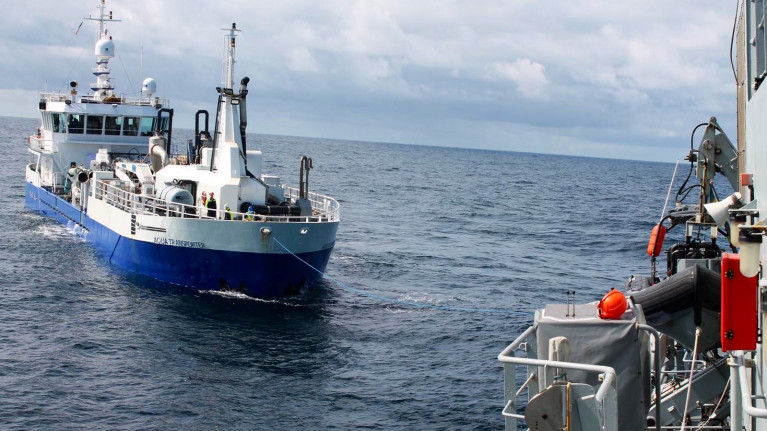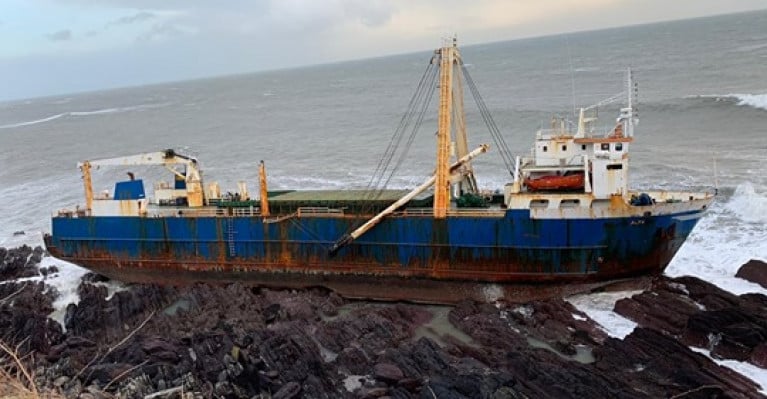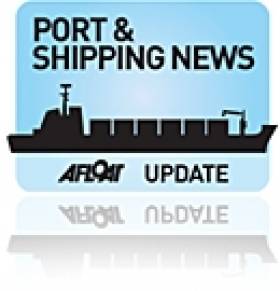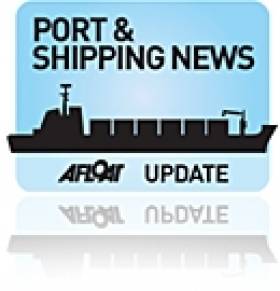Displaying items by tag: CargoShip
Potential Ecological Disaster Averted by Navy off Galway Coast
Off Ireland's west coast a potential ecological disaster was averted when the Naval Service intervened to prevent a cargoship laden with oil from crashing against rocks.
Aqua Transporter, reports Irish Examiner, was carrying 32,000 cubic tonnes of fuel and two cubic tonnes of lubricating oil, had lost power and was drifting towards rocks. If it had collided, its contents would have caused a major pollution incident along the Wild Atlantic Way.
The Coast Guard contacted the Naval Service after receiving a request for help from the ship's Norwegian skipper, who reported he had lost engine power and was drifting. Fortunately, LÉ Niamh was on routine patrol just a few miles away.
The navy ship, under the captaincy of Lieutenant Commander Claire Murphy, responded to the early morning emergency request on Tuesday to help the cargo ship and its crew of six. It was drifting a few miles off Slyne Head, near Galway.
More about the incident by clicking here.
Afloat.ie adds the Norwegian flagged 60m fish-carrier in recent days departed Rathmullen, Co. Donegal is now docked at the Port of Galway in the Dun Aengus Dock.
Maritime salvage experts internationally say it could cost upwards of €10m to salvage the (cargoship) MV Alta.
The 'ghost ship' washed ashore off the Cork coast earlier this year.
The Receiver of Wreck said it was still trying to establish ownership as fears grow locally that she will be left to rust on the coastline.
Storm Dennis ravaged the country in February and in its wake the MV Alta washed ashore.
Abandoned 16 months earlier by her crew near Bermuda, the 44-year-old merchant ship had been adrift in the Atlantic, before the it washed up near Ballycotton.
In the days that followed, Cork County Council removed any environmental risk and since then the Receiver of Wreck has been trying to establish ownership and in turn whose is responsible for the ship.
More on this story from RTE News here.
Migrants Found ‘Hiding’ on Cargo Ship at Port of Waterford
A total of eight migrants discovered “hiding” on board a cargo ship at a port near Waterford city on Wednesday are likely to be sent back to France in the coming days.
The discovery, reports The Irish Times, was made by the crew of a “bulk cargo ship” that was travelling from St Nazaire in France to Belview Port. Three men fled the ship after being discovered, but were apprehended by gardaí a short time later.
A garda spokesman said the eight migrants, all believed to be adult males from Albania, were found to be in good health.
“Gardaí in Waterford were alerted to an incident today, Wednesday 4th December 2019, in Belview, Co Waterford where eight males were discovered by the crew in hiding on a bulk cargo ship travelling from France to Ireland,” the spokesman said in a statement.
“Garda immigration officers attached to Waterford Garda station are currently dealing with the males and they will be processed under the immigration law.”
The eight men are are believed to have stowed away on board the bulk carrier at St Nazaire before it sailed to Belview Port, where it arrived at around 9am on Wednesday. Port officials alerted gardaí to the presence of the stowaways.
For much more from the newspaper's coverage click here.
Ferry-Tales of the Unexpected Continue in Galway Docks Drama
Despite successfully loading the first ferry, the 172 gross tonnes ferry Clann na nOileain yesterday morning, which took four hours, the time to secure the vessel on the cargoship's deck continued much longer than anticipted.
As a consequence this led to further delays in the the clearance of existing cargo so to enable sufficient space to load the second ferry onboard the Thor Gitta.
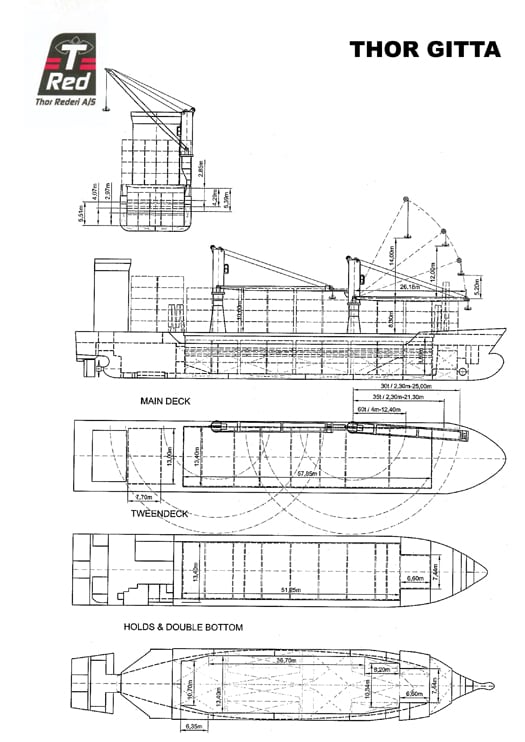
The 4,078 gross tonnes heavy-cargo liftship was due to have started loading the second ferry the 169 tonnes ferry Clann Eagle I yesterday afternoon but this has been delayed until 12 noon today.
The Danish-flagged Thor Gitta has been in Galway for over a fortnight. She berthed with her starboard side facing alongside the quay. With this orientation the cargoship's two-deck mounted cranes swing out on the opposite port side which were used to raise the first ferry out of the water on 7 April.
On that ocasion the forward sling snapped causing the Clann na nOileain to plunge into the waters within the port's single dock named the Dun Aengus Dock.
In recent daysThor Gitta has shifted berths which has resulted in the 100m long vessel berthing on her starboard side again next to the dock's quayside. The deck-mounted cranes on the port side continue to face out overlooking the open water of the dock.
The loading of Clann na nOileain is all the more skillfull considering that the 27m length of the ferry had to be hoisted and swung at an angle between the narrow span of the two deck mounted cranes.
For file photos of vessels in loading mode from the Rederi A/S fleet owners of the Thor Gitta click here.
Thor Gitta is the second chartered vessel called in to assist in the transportation of the two former Aran Islands fast-ferries.
The other cargoship, the longer 120 metre Patanal, ran aground at the end of March during stormy seas after dragging its anchor in Casla Bay, at the entrance to Rossaveal harbour. The 7,002 tonnes vessel sought initial repairs before leaving Galway Bay last week for further work in Germany.
The monuhull fast ferry pair were custom built in France for Bad Teoranta (trading as Aran Direct) but the company went into recievership.
At an auction held in Galway last month the vessels did not sale despite bids reaching €950,000, they were withdrawn at the auction. The ferries were later sold for a sum believed to be seven-figures to an operator based in the Indian Ocean island of Mauritius.
First of Two Ferries Loaded in Galway
The Clann na nOileáin was first loaded onboard this morning whereas her sister Clann Eagle I will be hoisted this afterrnoon. It is expected that this procedure will take around four hours to complete.
The 234-passenger ferries have been the centre of attention since two previous attempts proved unsuccessful following incidents in the mid-west port.
On the first attempt that took place nearly a fortnight ago, three men onboard the ferry were injured when the ships's crane-sling snapped when handling the 170 tonnes ferry Clann na nOileáin.
Fortunately the ferry was hanging over the water and splashed into Dun Aengus Dock rather than landing on the hold of the 4,078 gross tonnes cargo-vessel Thor Gitta. In the second attempt last
Saturday one of the cargoship's cranes sounded a safety alarm which halted proceedings.
The Danish-flagged Thor Gitta is the second heavy-lift cargoship that has been called in to assist in transporting the two former Aran Islands fast-ferries. The 100m cargoship is owned by Thor Rederi A/S of Svendborg and is expected to depart Galway tommorrow morning.
The first heavylift vessel the German-flagged Patanal grounded in rough seas after dragging its anchor in Casla Bay at the entrance to Rossaveal, where the ferries were originally based in readiness for loading.
Patanal suffered hull damage and was taken into Galway Bay for preliminary repair work. Last week the 7,002grt vessel operated by Harren + Partners, departed the bay to undergo further repairs at a dry-dock in Bremerhaven.
Ongoing Ferry Saga As Cargoship is Detained
Harbourmaster Capt. Brian Sheridan, confirmed yesterday evening that the Danish flagged vessel had been detained at lunchtime on the instructions of the admiralty marshal, a High Court judge, acting under maritime law. Until matters are resolved, a ship's keeper has been placed onboard by the Revenue Commissioners.
New series of 'Customs' on RTÉ One
The second series of 'Customs' returns to television screens next Wednesday (17 November) on RTÉ One at 8.30pm. The Revenue Commissioners customs cutter, RCC Faire, which officially entered service in October of last year, will feature in the new series.
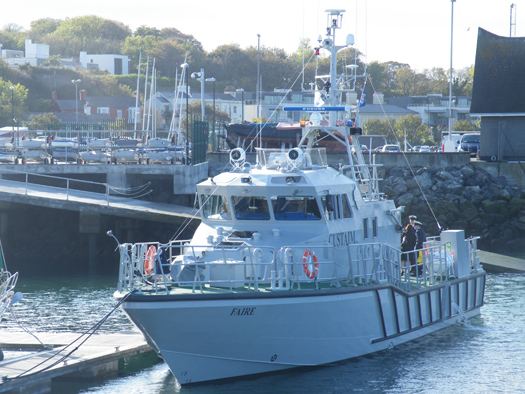
RCC Faire at Howth Harbour on the day of her naming ceremony on 16 October 2009. Photo: Jehan Ashmore / ShipSNAPS
To be broadcast in six-parts, the series will provide unprecedented access into the daily operations of the custom officers.'Customs' examines how the country is dealing with increasing levels of illegally imported materials and substances.
Custom officers found shipments of drugs in the strangest places: a doll's house, picture frames, the bottom of a massive cargo ship. In addition the seizure of contraband cigarettes, vehicles, large
quantities of money and the more bizarre discovery of a Colombian snake.
New series of 'Customs' on RTÉ One
To be broadcast in six-parts, the series will provide unprecedented access into the daily operations of the custom officers.'Customs' examines how the country is dealing with increasing levels of illegally imported materials and substances.
Custom officers found shipments of drugs in the strangest places: a doll's house,picture frames, the bottom of a massive cargo ship. In addition the seizure of contraband cigarettes, vehicles, large quantities of money and the more bizarre discovery of a Colombian snake.


























